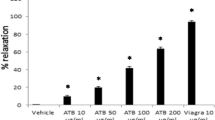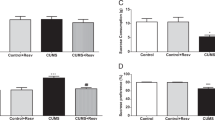Abstract
We examined the effects of trans-resveratrol on male reproductive functions; ex-vivo penile erection and in-vivo sperm counts and quality. For the ex-vivo study, the relaxation effects of resveratrol on isolated New Zealand white rabbit corpus cavernosum, precontracted by phenylephrine (5×10−5 M) were measured. The in-vivo study measured reproductive organ weights, blood testosterone levels, testicular histopathology, sperm counts, as well as the epididymal sperm motility and deformity of male ICR mice given an oral dose of resveratrol (50 mg/kg) for 28 days. Resveratrol elicited a concentration-dependent relaxing effect on corpus cavernosum, leading to a median effective concentration (EC50) of 0.29 mg/mL. Repeated treatment with resveratrol (50 mg/kg) did not cause an increase in body weight, reproductive organ weight or testicular microscopic findings; however, resveratrol did elicit an increase in blood testosterone concentration, testicular sperm counts and epididymal sperm motility by 51.6%, 15.8% and 23.3%, respectively, without influence on sperm deformity. In conclusion, we propose that resveratrol has a positive effect on male reproductive function by triggering a penile erection, as well as enhancing blood testosterone levels, testicular sperm counts, and epididymal sperm motility.
Similar content being viewed by others
References
Akmal, M., Qadri, J. Q., Al-Waili, N. S., Thangal, S., Haq, A., and Saloom, K. Y., Improvement in human semen quality after oral supplementation of vitamin C. J. Med. Food, 9, 440–442 (2006).
Andersson, K. E. and Wagner, G, Physiology of penile erection. Physiol. Rev., 75, 191–236 (1995).
Carreau, S., Silandre, D., Bourguiba, S., Hamden, K., Said, L., Lambard, S., Galeraud-Denis, I., and Delalande, C., Estrogens and male reproduction: a new concept. Braz. J. Med. Biol. Res. 40, 761–768 (2007).
Chen, C. K. and Pace-Asciak, C. R., Vasorelaxing activity of resveratrol and quercetin in isolated rat aorta. Gen. Pharmac., 27, 363–366 (1996).
Crowell, J. A., Korytko, P. J., Morrissey, R. L., Booth, T. D., and Levine, B. S., Resveratrol-associated renal toxicity. Toxicol. Sci., 82, 614–619 (2004).
Fouad, R., Vivien, K., and Ronald, S., Male sexual function and its disorders: physiology, pathophysiology, clinical investigation, and treatment. Endocr. Rev., 22, 342–388 (1993).
Gehm, B. D., McAndrews, J. M., Chien, P. Y., and Jameson, J. L., Resveratrol, a polyphenolic compound found in grapes and wine, is a agonist for the estrogen receptor. Proc. Natl. Acad. Sci. USA, 94, 14138–14143 (1997).
Gruenewald, D. A. and Matsumoto, A. M., Testosterone supplementation therapy for older men: potential benefits and risks. J. Am. Geriatr. Soc., 51, 101–115 (2003).
Henry, L. A. and Witt, D. M., Resveratrol: phytoestrogen effects on reproductive physiology and behavior in female rats. Horm. Behav., 41, 220–228 (2002).
Hinrichsen, M. J. and Blagaier, J. A., Evidence supporting the existence of sperm maturation in the human epididymis. J. Reprod. Fertil., 60, 291–294 (1980).
Holdcraft, R. W. and Braun, R. E., Hormonal regulation of spermatogenesis. Int. J. Androl., 27, 335–342 (2004).
Jeon, J. H., Shin, S., Park, D., Jang, J. Y., Choi, B., Kang, J.-K., Hwang, S.-Y., and Kim, J.-C., Kim, B.-Y., Kim, M. R., and Kim, Y.-B., Fermentation filtrates of Rubus coreanus relax the corpus cavernosum and increase the sperm count and motility. J. Med. Food in press (2007).
Johannes, C. B., Araujo, A. B., Feldman, H. A., Derby, C. A., Kleinman, K. P., and McKinlay, J. B., Incidence of erectile dysfunction in men 40 to 69 years old; longitudinal results from the Massachusetts male aging study. J. Urol., 163, 460–463 (2000).
Jouannet, P., Wang, C., Eustache, F., Kold-Jensen, T., and Auger, J., Semen quality and male reproductive health: the controversy about human sperm concentration decline. Acta Pathol. Microbiol. Immunol. Scand., 109, 333–344 (2001).
Juan, M. E., Gonzalez-Pons, E., Munuera, T., Ballester, J., Rodriguez-Gil, J. E., and Planas, J. M., trans-Resveratrol, a naturall antioxidant from grapes, increases sperm output in healthy rats. J. Nutr., 135, 757–760 (2005).
Kleinert, H., Wallerath, T., Euchenhofer, C., Ihrig-Biedert, I., Li, H., and Förstermann, U., Estrogens increase transcription of the human endothelial NO synthase gene: analysis of the transcription factors involved. Hypertension, 31, 582–588 (1998).
Li, H., Wallerath, T., and Förstermann, U., Physiological mechanisms regulating the expression of endothelial-type NO synthase. Nitric oxide Biol. Chem., 7, 103–118 (2002).
Padama-Nathan, H., Eardly, I., Kloner, R. A., Laties, A. M., and Montorsi, F., A 4 year update on the safety of sildenafil citrate (Viagra). Urology, 60(suppl. 2B), 67–90 (2002).
Sinclair, S., Male fertility: nutritional and environmental considerations. Altern. Med. Rev., 5, 28–38 (2005).
Wallerath, T., Deckert, G., Ternes, T., Anderson, H., Li, H., Witte, K., and Förstermann, U., Resveratrol, a polyphenolic phytoalexin present in red wine, enhances expression and activity of endothelial nitric oxide synthase. Circulation, 106, 1652–1658 (2002).
Wallerath, T., Poleo, D., Li, H., and Forstermann, U., Red wine increase the expression of human endothelial nitric oxide synthase: a mechanism that may contribute to its beneficial cardiovascular effects. J. Am. College Cardiol., 41, 479–478 (2003).
Wang, Z., Chen, Y., Lavinsky, N., Hsieh, T., Ungvari, Z., and Wu, J. M., Regulation of proliferation and gene expression in cultured human aortic smooth muscle cells by resveratrol and standardized grape extracts. Biochem. Biophys. Res. Commun., 346, 367–376 (2006).
Author information
Authors and Affiliations
Corresponding author
Rights and permissions
About this article
Cite this article
Shin, S., Jeon, J.H., Park, D. et al. trans-resveratrol relaxes the corpus cavernosum ex vivo and enhances testosterone levels and sperm quality in vivo. Arch. Pharm. Res. 31, 83–87 (2008). https://doi.org/10.1007/s12272-008-1124-7
Received:
Published:
Issue Date:
DOI: https://doi.org/10.1007/s12272-008-1124-7




